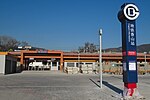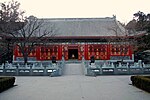Xiangshan Subdistrict, Beijing

Xiangshan Subdistrict (Chinese: 香山街道; pinyin: Xiāngshān Jiēdào) is a subdistrict situated on the western portion of Haidian District, Beijing, China. It borders Wenquan and Xibeiwan Towns in its north, Qinglongqiao Subdistrict in its east, Sijiqing Town and Wulituo Subdistrict in its south, and Junzhuang Town in its west. In 2020, it had 27,614 inhabitants under its administration.This subdistrict got its name from Xiangshan (Fragrant Hills) (Chinese: 香山; pinyin: Xiāngshān) in the subdistrict. The name derives from the highest peak of Fragrant Hills, Xianglu Feng (Incense Burner Peak), a 557-meter (1,827 ft) hill with two large stones resembling incense burners at the top.
Excerpt from the Wikipedia article Xiangshan Subdistrict, Beijing (License: CC BY-SA 3.0, Authors, Images).Xiangshan Subdistrict, Beijing
Xiangshan Road, Haidian District Xiangshan
Geographical coordinates (GPS) Address Nearby Places Show on map
Geographical coordinates (GPS)
| Latitude | Longitude |
|---|---|
| N 39.992777777778 ° | E 116.2 ° |
Address
香山路
Xiangshan Road
100094 Haidian District, Xiangshan
Beijing, China
Open on Google Maps










